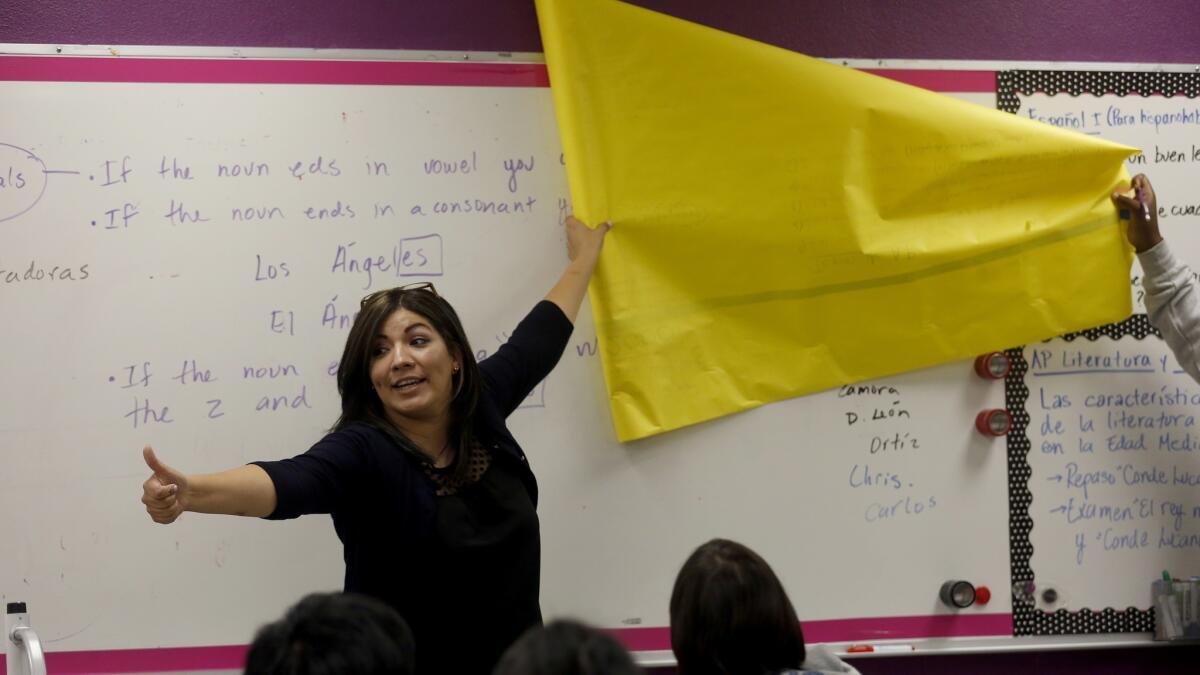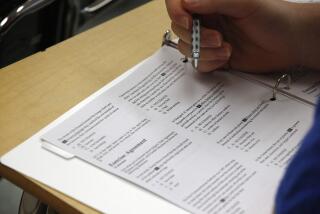California test scores have barely improved. What to do about it is hotly debated

Over the last decade, California took a national lead in making its curriculum more relevant to college and work and in toughening up its standardized tests to measure the new goals. The hope was that students would soon demonstrate the benefits.
But judging by the latest test results, the effort is stalling far short of success.
What do about it is hotly debated.
Four years into a new testing program, student scores inched up this year but gains among younger students were nearly canceled out by a drop at the high school level.
More than three million students in third through eighth grade and 11th grade took the California Assessment of Student Performance and Progress in the spring. The pace of improvement was a little better than last year — when scores were nearly flat — but the results were hardly cause for celebration. Just under half the students met standards in English and fewer than 4 in 10 in math.
You have to look on the right side of the decimal point to get any picture of progress. In English, 49.9% of students met or exceeded state standards in English, compared to 48.6% last year. In math, 38.7% met the standard compared to 37.6% last year.
The strongest gains on the tests, which students take on computers, were in reading scores in third grade (up 4.3 percentage points) and fourth grade (up 3.6 percentage points). The youngest students tested also made the biggest strides in math, although those gains were not as large.
“We’re encouraged by what we see, especially since these tests are more rigorous than previous paper and pencil tests,” said state Supt. of Public Instruction Tom Torlakson. “However, we need to make sure all students continue to make progress.”
Less encouraged were advocates who want to see the state respond aggressively.
“There is no excuse for such abysmal outcomes,” said Bill Lucia, the head of Sacramento-based EdVoice. The test results “once again paint a bleak picture of the state of public education, providing further evidence of a seriously broken system.”
Los Angeles Unified, California’s largest school system, improved at a faster rate than the state overall, though its scores still fell below state averages. About 42% of L.A. Unified students met or exceeded state standards in reading, while about 32% did so in math.
“L.A. Unified’s modest growth shows we have more work to do, especially with our African American, Latino and low-income students,” Supt. Austin Beutner said. “The status quo is simply not good enough.”
The new tests are intended to match more closely, grade by grade, what students need to learn to become ready for college or work. The changes drove scores downward, suggesting that students were less prepared than the older tests had indicated.
Many questions on the test are multiple choice, but a correct answer produces a harder question to follow, while a wrong answer yields an easier next question. This “adaptive” test seeks to precisely diagnose what a student needs to learn.
The test also includes what the state calls a performance task, which requires analysis and writing. A sample fourth-grade task begins with a teacher-led explanation about how animals defend themselves. The class watches a video and there’s a discussion. Students then have to read an article and answer questions that incorporate other material they’ve seen and discussed. They then have 70 minutes to write a paper on animal defenses.
It isn’t just the test that has changed. California’s revamped learning goals put increased emphasis, for example, on analytical writing and reading, and on studying more-difficult nonfiction. Math classes are supposed to lead to high school calculus.
In this testing round, however, 11th-graders performed worse in math than their peers the year before, and their scores in English were nearly 4 percentage points lower. The performance of 11th-graders has, in fact, gone down slightly since the new testing program started.
Although test scores remain a widely used snapshot of progress, they don’t cover every subject and are far from the only proper measure of an effective program.
The Antelope Valley Union High School District, where about 70% of students are from low-income families, has seen a worrisome downward trend in scores, which were not high to begin with. Fourteen percent of students met state standards in math, 39% in English.
But the district is doing better, said Supt. David J. Vierra, with improvements including an updated curriculum and online tutoring available 24 hours a day. And it received special recognition this month for its efforts from the Western Association of Schools and Colleges, which accredits California schools.
A major source of disappointment statewide is the persistent gap that separates Asian and white students from black and Latino students. One example: 32% of black students met the standard in reading compared with 76% of Asians and 65% of white students. The gap in reading narrowed slightly for Latinos and black students in 2018, by less than 1 percentage point, as did the gap in math for Latinos. But the math gap widened slightly for black students.
At the current rate of improvement, it would take generations for black students to catch up, said Elisha Smith Arrillaga, a senior official with Education Trust-West, an Oakland-based advocacy group.
“I have a son and … I would never be content to know that it would be his grandchildren, and not him, that have the educational opportunities that he deserves,” Arrillaga said.
Most advocates and experts want more education funding, but they don’t agree on how best to spend it.
Lucia, of EdVoice, wants the state to mandate change when schools perform poorly year after year. Some experts want to focus on early education, including counseling for parents. Teachers in Los Angeles may decide to strike to push for hiring more teachers to lower class size and more nurses and counselors to support the “whole child.”
UCLA education professor Patricia Gandara pinpoints school enrollment patterns that separate black and brown students from their higher-achieving peers. In large measure, the gap represents students in schools with too few resources and unstable staffing, said Gandara.
“The standards that are being set are reasonable if three-quarters of the Asian kids … and two-thirds of the white kids are meeting or exceeding them,” Gandara said. ”We want the same for all children.”
Students in San Marino Unified, which serves a high-income community, aced the old test and also performed well on the new one, with 87% of students proficient or better in both English and math.
The availability and resources of parents make a huge difference, said interim Supt. Loren Kleinrock. The San Marino Schools Foundation raises about $2.5 million annually for the district’s four schools, and each campus also does its own fundraising.
The money allows for smaller classes and special programs, creating working conditions that attract able teachers and administrators, Kleinrock said.
Latino students in the district scored higher than in the state as a whole, although an achievement gap remained.
“This data is valuable for us because … we know we have work to do,” Kleinrock said.
Twitter: @howardblume
More to Read
Start your day right
Sign up for Essential California for news, features and recommendations from the L.A. Times and beyond in your inbox six days a week.
You may occasionally receive promotional content from the Los Angeles Times.









